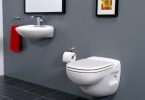 Text by Blair Korchinski
Text by Blair Korchinski
There are a lot of options out there when it comes to tubs and showers. Size and space are considerations, of course, but there are a lot of others as well. Which options you choose depends on your personal tastes as much as anything else, but you should choose carefully because your shower or tub is something that you will have to live for quite some time.
There are many choices, from a standard tub to a shower that will massage you from head to toe, and everything in between. Most tubs have a shower option built into them and, even in the simplest configurations, showers can be added through either plumbing in the wall or a hand-held showerhead affixed to the faucet.
Tubs and showers are available in a variety of materials as well. Cast iron, fiberglass and acrylic are the most common materials for bath tubs. Acrylic and fiberglass tubs are available as one-piece units that include the surround as well as the standard tub design. Some have fixtures built in, others pre-cut holes for the fixtures. More expensive models are also available with a variety of built-in soap dishes and shelves for bath and shower items. If you should choose a cast iron tub or a standard acrylic or fiberglass tub, you can find a variety of surrounds that offer many or all of the same options.
You can choose to have tile installed around your tub, or you can go with a tile board product. While tile is preferred for reasons of durability, waterproofing and appearance, tile board may be dictated by budget. In either case, accessories are available that can be installed right in the wall. Accessories that extend into the stud wall should not be installed in insulated or out walls however, as they will interfere with the efficiency of the insulation. No matter what kind of surround material you choose, or which options appeal to you, a water-resistant backing board should be used instead of normal drywall. Your kitchen and bath retailer will be able to suggest a suitable product.
While tile or a surround will protect the walls on three sides of your tub in most configurations, any sides not protected by something built in should have some sort of moveable covering so that you can access the tub. Traditionally this has been achieved with a shower curtain on a rail. While this simple solution has been around since the old claw-foot tub in the middle of a room was state of the art, it is still a workable solution. Even with most conventional tubs though, you may opt for sliding doors made of glass or acrylic.
Showers are available without tubs, of course. The most basic version, and one that can be easily customized to most spaces, is a simple, tiled space.
That brings us to fixtures. Again, there are several styles and configurations. The days of two taps, a pull to engage the shower head, and another pull to open and close the drain are long gone.
Latest posts by Canadian Home Trends (see all)
- Understanding The Importance of Great Design - January 7, 2026
- The Green Effect: To Clean or Not to Clean - January 7, 2026
- Functional Warm Addition - January 7, 2026






